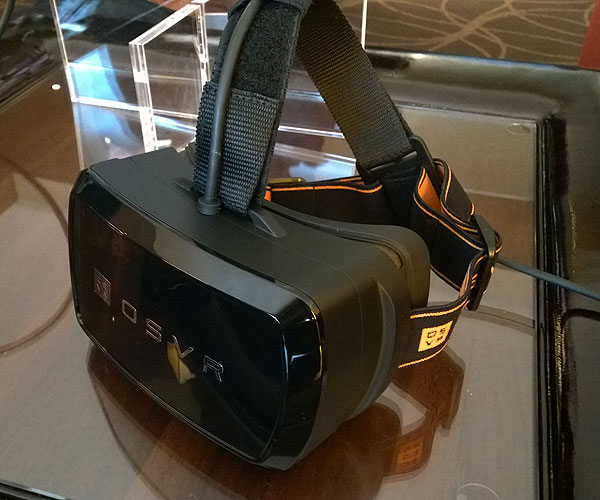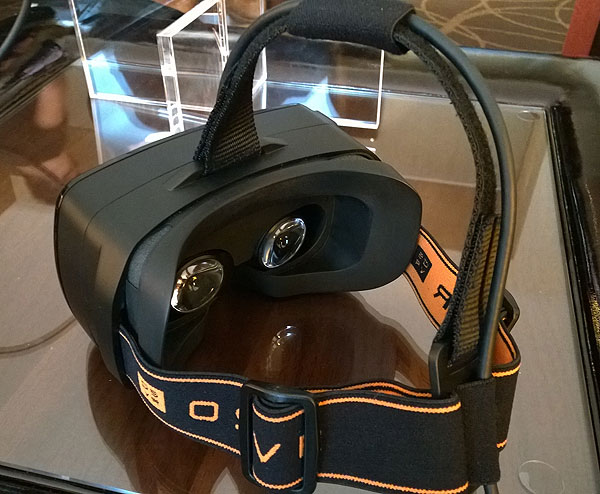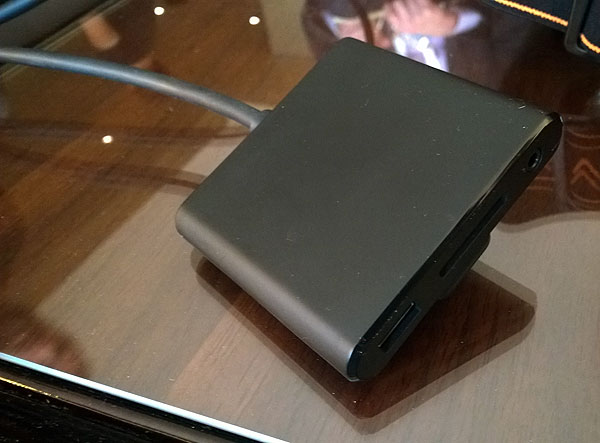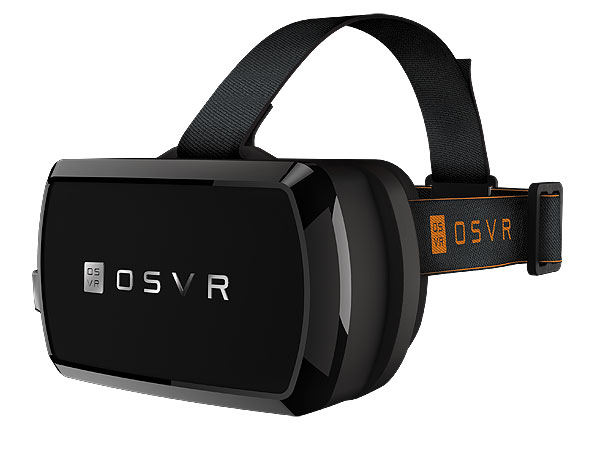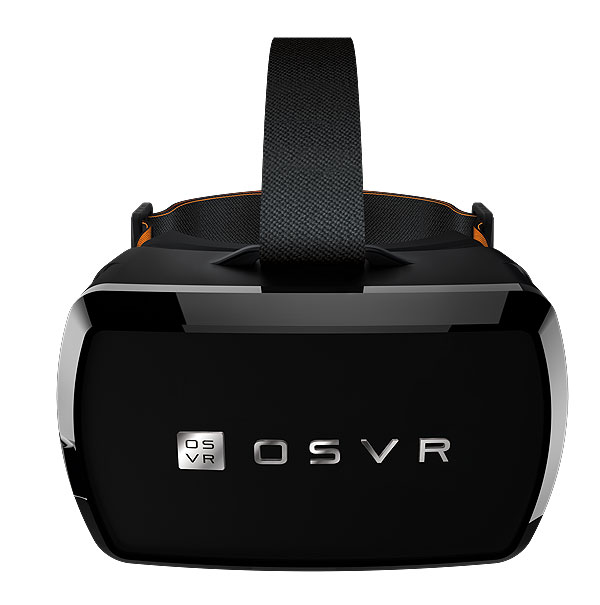Razer Leads OSVR Initiative To Provide Open Standard For Virtual Reality; But What About Oculus?
PC Peripherals giant Razer has, somewhat surprisingly, emerged as a serious advocate for an open-source virtual reality ecosystem. The company announced the Open Source Virtual-Reality (OSVR) standard today, its goal to provide both hardware and software support for all aspects of virtual reality gaming. This includes support for diverse aspects of the emerging VR industry such as head-mounted displays (HMDs), game controllers, software engines, and device plugins across any operating system. A Razer rep mentioned that we could think of it as "the Android of VR." In theory, with the right plugins, Oculus' Rift would be fully compatible with OSVR.
More than simply announcing its intentions, however, Razer has gone so far as to design a generic VR-HMD it calls the Hacker. As a truly open-source project, anyone with Internet access can download the full schematics for the Hacker -- completely free of charge -- at www.osvr.com starting Jan. 6, along with a list of required components and 3D printer-capable source files. For people without 3D printing resources and/or the desire to put together their own kit, Razer offers a Hacker Dev kit for $200. The company will begin to accept orders for the dev kit during CES, and availability is expected in June this year.
Let's consider the Hacker dev kit and some of the key components. The HMD includes a sensor hub with integrated accelerometer, gyroscope, and compass. It features an external USB 3.0 connection for accessories and two more for internal expansion. The display is a 5.5" FHD with 1080p resolution, but is unfortunately limited to 60 FPS. The optics module uses a two-lens setup for eye pressure relief and minimal distortion. The mask accommodates mobile phone displays if desired. Not meant to be a pre-release prototype, the Hacker is a customizable and configurable development tool. One unique aspect is the belt box module, which provides not only connectivity and a surround sound audio codec, but also an improved cable management experience compared to having wires connect directly to the user's head. The only obvious omission is a lack of positional tracking hardware, but Razer told us that the HMD provides ports for just this type of plugin. It's a modular design.
Now that we've covered the basics, let's consider the ramifications of Razer's move. The company rep told us that developers are hesitant to get locked into a position where they are forced to support a single, proprietary standard. It's a valid concern, but it's not hard to read between the lines; developers of software and hardware are beginning to become aware that they have virtually handed control of the VR industry to a single company. That company is, of course, Oculus.
It's an easy thing to do when the driving force behind Oculus is Palmer Luckey, a genuinely likeable personality who I truly believe has the best interests of VR close to his heart. It almost feels like heresy to suggest that open standards are a good idea when this gentleman and John Carmack have done such a vigilant and carefully thought-out job of dragging VR from obscurity to massive popularity in an incredibly short amount of time. Now they're backed by Facebook, a company with an incredible amount of resources to help the cause. These men are my heroes, and I say that without a shred of sarcasm. Nevertheless, it might be time to ask if Oculus' de facto monopoly on setting the industry standard is something the world should leave to its sole discretion.
I've probably gone on a bit of a tangent with this point, but it's hard to skirt when it seems pretty clear that OSVR is a natural response to Oculus' dominance. This is the second open-standard for VR announced in as many days, by the way, as we reported yesterday that the Immersive Technology Alliance (ITA) has its own plan to provide a non-partisan industry standard. In fact, the Razer representative was aware of the ITA's efforts when I mentioned it, and he told us that they plan to meet up for a discussion. Perhaps in the future the ITA and Razer will join forces in order to create an even stronger, united, and open VR standard.
Regardless, the VR space has had a major change with Razer's announcement. It's one thing to announce plans, but it's another thing entirely to offer HMD dev kit hardware at $200, undercutting Oculus' Rift by $100 and making software and hardware development in this field a lot more accessible. At this price point we doubt that Razer is making money from the dev kit, and the team seems genuinely enthusiastic about an open and accessible future for VR. It's difficult to criticize that goal.
Get Tom's Hardware's best news and in-depth reviews, straight to your inbox.
Follow us @tomshardware, on Facebook and on Google+.
Don Woligroski was a former senior hardware editor for Tom's Hardware. He has covered a wide range of PC hardware topics, including CPUs, GPUs, system building, and emerging technologies.
-
universal remonster I'm all for competition and more choice in order to drive innovation ad lower prices, but when you look at the hardware aspect of all these other "me too's" it is clear that they are simply just releasing something to have a presence in the market, and not advance it. A 1080p screen most definitely does not cut it. Oculus knows this, and have put off release until the hardware can meet their expectations. The very first thing noticed when using my DK2 was the screen door effect from too low of pixel density that 5" 1080p screens have when they sit an inch off your eyeball. There is no fine detail in textures, and the large pixels are a distraction. Being a dev kit, I don't knock it at all and their new prototype after DK2 does have a higher res screen. But all of these other companies seem to think users associate 1080p with high def and therefore it must look good. Perhaps its "good enough" for console users (such as the Morpheus) but for anyone that is accustom to viewing or playing on a PC monitor is going to be disappointed. And I guess that is my point, For a new emerging market, you have a company ,Oculus, that knows not only the importance, but the absolute necessity of making a great first impression to consumers in order for VR to thrive and have delayed release in order to do so. Now we are getting company after company releasing "good enough" hardware, that can use 1080p screens and some marketing fluff to be a "me too" which does nothing good for the consumer or the market.Reply
I'm all for the software aspect though and creating open platforms. -
alidan after having razer products, and everyone failing a few months after i got it, with my mouse being the exception and lasting 6 months on average... i will never trust razor for anything that is mission critical... as a gamer, that means my monitor.Reply -
CobraMatte Seems while Oculus is taking their time to make a quality product there is a vacuum in the VR market and everyone wants to cash in. Competition is good. I just don't like to see it cheapen the idea of what VR HMDs can be.Reply -
Champion_hero I guess the beauty of this being modular though, is that there is 'technically' no reason you couldn't improve the screen and adapt the software to be better. What Razer are offering here is a 'base model' per se. An idea. Something to get you started without costing an arm & a leg.Reply
Phones already have 1440p screens, so I can't see why someone with the knowledge/willpower couldn't simply buy a "Replacement" phone screen, stick it in this and mod the software to work it with. Afterall, OR uses a Note 3 screen if I'm not mistaken... -
trevor_chdwck I would expect it to use FreeSync instead of GSync, given it's opensource basis. Also, @ universal remonster, while the hardware is a me too, what your missing is the fact that the entire design is open source and modular, they are creating a starting point that could easily change as new hardware becomes available and instead of waiting for "the company" to implement it and release it, anyone can implement it and that improvement is then shared with the community. This agility is partially why Android took off so well, the price being the other point. Razer has potentially unveiled the end of Oculus as we know it...Reply
